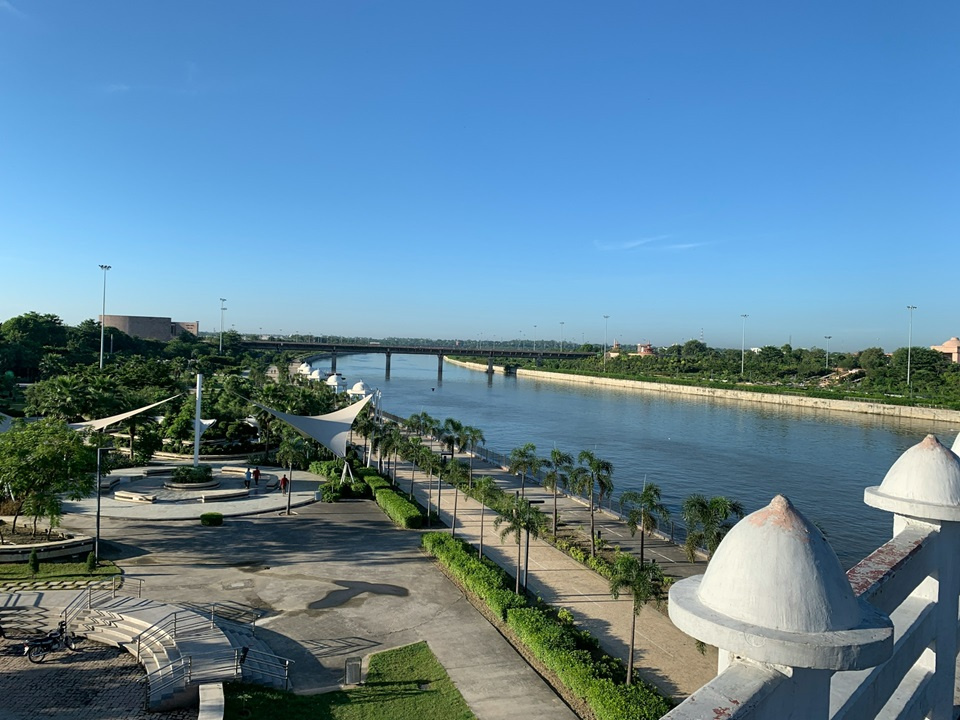
Overview of Lucknow’s Climate
Lucknow, the vibrant capital of Uttar Pradesh, experiences a humid subtropical climate characterized by distinct seasonal variations that influence daily life, agriculture, and tourism. Positioned along the banks of the Gomti River in northern India, the city endures extreme temperatures ranging from chilly winters to scorching summers, interspersed with heavy monsoon downpours. As of late October 2025, unseasonal rains have brought a temporary respite from the lingering warmth, with daytime temperatures expected to dip by two to four degrees Celsius over the next few days, according to meteorological updates from regional observatories.
This transitional weather underscores the city’s susceptibility to shifting patterns, where post-monsoon showers occasionally extend into autumn, affecting outdoor activities and urban mobility. Historical data reveals an annual average temperature hovering around 25 degrees Celsius, with precipitation totaling approximately 990 millimeters concentrated primarily during the rainy season. Humidity levels fluctuate significantly, peaking during the humid summer months and dipping to more comfortable ranges in winter.
Cloud cover and daylight hours further define the climatic rhythm, with the sunniest periods occurring in late spring and the cloudiest in mid-summer. These elements collectively shape Lucknow’s environmental profile, making it essential for residents and visitors alike to adapt to the rhythms of heat, rain, and occasional fog. Recent analyses indicate a worsening climate severity score of 76 out of 100 for 2025, highlighting a 60.7 percent deterioration over the past 15 years, which amplifies the urgency for informed seasonal planning.
Historical Patterns and Annual Averages
Over the years, Lucknow’s weather has followed a predictable yet intensifying cycle, with the hottest month, May, recording average highs of 40 degrees Celsius and the coldest, January, seeing lows of 7.5 degrees Celsius. Annual sunshine averages nine hours per day in peak months like April and May, contrasting sharply with five hours in July and August due to overcast skies. The ultraviolet index reaches a maximum of 12 from May through August, necessitating protective measures during these periods.
Precipitation patterns show July as the wettest month with 270 millimeters of rain across 12 days, while April remains the driest with just five millimeters. Daylight extends to nearly 14 hours in June, the longest day, and contracts to about 10.5 hours in December. These averages, drawn from long-term observations, provide a baseline for understanding deviations influenced by broader climatic shifts.
Seasonal Breakdown
The division of the year into four primary seasons offers a structured lens through which to view Lucknow’s meteorological behavior, each bringing unique atmospheric conditions that impact everything from cultural festivals to infrastructural resilience. Winter arrives gently, providing a brief interlude of moderation before the relentless summer heat takes hold. Monsoon transforms the arid landscape into a lush expanse, while the post-monsoon phase bridges the extremes with milder, more equitable weather.
These seasons are not merely chronological markers but pivotal influencers on ecological balance and human endeavors within the city. Agricultural cycles align closely with these shifts, with sowing and harvesting timed to rainfall reliability. Urban planning, too, incorporates seasonal forecasts to manage water resources and heat mitigation strategies effectively.
In 2025, early indicators suggest a potentially intensified winter chill due to emerging La Niña conditions, with probabilities exceeding 60 percent from November through January, potentially lowering temperatures further than historical norms. Such developments add layers of complexity to seasonal preparations, prompting enhanced monitoring by local authorities.
Winter: December to February
Winter in Lucknow ushers in cooler, drier air, with average high temperatures ranging from 22.5 degrees Celsius in January to 25.8 degrees Celsius in February, and lows dipping to 7.5 degrees Celsius at their coldest. Rainfall remains sparse, totaling around 50 millimeters across the season, fostering clear skies and minimal humidity that enhances visibility but occasionally leads to foggy mornings. This period marks the cool season, where daily highs rarely exceed 24 degrees Celsius, providing a stark contrast to the preceding heat.
Humidity levels stay low, contributing to comfortable daytime conditions ideal for extended outdoor exposure. Cloud cover is predominantly clear, with about 85 percent of days featuring unobstructed skies, allowing for ample sunlight despite shorter daylight hours of 10.5 to 11 hours. January stands out as the month’s with the lowest temperatures, often accompanied by light mists that dissipate by midday.
Recent events in early 2025, such as a cold wave in January that brought dense fog and shivering lows, illustrate the season’s potential for abrupt chills, disrupting transportation and daily commutes. These episodes, while brief, emphasize the need for layered clothing and heated indoor spaces during evenings. Overall, winter’s mild demeanor supports a surge in festive activities, drawing crowds to heritage sites under pleasant atmospheric conditions.
Summer: March to May
Summer descends with escalating heat, as average highs climb from 32 degrees Celsius in March to a blistering 40 degrees Celsius in May, accompanied by lows reaching 24.6 degrees Celsius by late season. Precipitation is negligible, with totals under 20 millimeters, resulting in arid conditions that exacerbate dust and heat discomfort. This pre-monsoon phase features extended daylight up to 13.8 hours and intense sunshine averaging nine hours daily, pushing the perceived temperature even higher.
Humidity begins to rise toward May, introducing muggy undertones that make the air feel oppressive, with dew points signaling increasing discomfort. Cloud cover remains sparse at eight to 18 percent, ensuring relentless solar exposure and a UV index peaking at 12. April emerges as the driest month, with virtually no rainy days, heightening the demand for hydration and shade.
In the first half of 2025, February’s unusual warmth transitioned into a hot spell, while May’s temperatures aligned with historical extremes, underscoring the lengthening heat duration observed in recent years. These patterns strain urban cooling systems and public health resources, with advisories for limiting midday exertions. The season’s intensity tests resilience, yet it precedes the relieving monsoons, offering a prelude to renewal.
Monsoon: June to September
The monsoon season blankets Lucknow in humidity and rain, with average highs moderating to 33.1 to 38.4 degrees Celsius and lows stabilizing around 26.7 degrees Celsius in June. Rainfall dominates, amassing 860 millimeters over the period, peaking at 270 millimeters in July across 12 to 18 rainy days monthly. High humidity, often exceeding 80 percent, combines with persistent cloud cover of 27 to 71 percent to create a steamy, overcast ambiance.
July and August witness the heaviest downpours, including thundershowers that temporarily cool the air but foster waterlogging in low-lying areas. Sunshine dwindles to five hours per day, while the UV index holds at 12, though frequent showers reduce direct exposure risks. This wet phase rejuvenates reservoirs and vegetation, yet it challenges mobility with slick roads and intermittent flooding.
Throughout 2025, monsoon patterns showed slight delays in onset but maintained intensity, contributing to irregular cycles noted in broader regional reports. These variations impact crop yields and vector-borne disease prevalence, necessitating vigilant public health measures. The season’s dual nature—revitalizing yet disruptive—defines its role in the annual cycle.
Post-Monsoon: October to November
Post-monsoon brings welcome moderation, with highs falling from 32.8 degrees Celsius in October to 29.2 degrees Celsius in November, and lows cooling to 12.8 degrees Celsius by season’s end. Rainfall tapers to 48 millimeters total, with November recording just seven millimeters over minimal days, ushering in drier, brighter conditions. Humidity decreases, easing the muggy residue of summer rains, while cloud cover reduces to 10 to 40 percent.
Daylight shortens gradually, and comfort levels rise with perceived temperatures between 18 and 28 degrees Celsius on clear days. October often features lingering showers, but November solidifies as rainless, enhancing outdoor viability. This transitional phase bridges the extremes, offering balanced weather for reflection and preparation.
As of October 2025, unseasonal rains have slightly prolonged the wet influence, dropping daytime highs and introducing cooler evenings, which aligns with forecasts of transitional variability. These events, while minor, highlight the evolving predictability of autumnal weather. The period’s pleasant equilibrium makes it a favored interlude before winter’s embrace.
Impacts of Climate Change on Lucknow’s Weather
Emerging climatic shifts are reshaping Lucknow’s seasonal profile, with 2025 marking a very high severity score driven by prolonged heat waves, erratic monsoons, and intensified winter fogs. Urbanization compounds these effects, trapping heat and pollutants to shorten life expectancy by an estimated 6.5 years due to poor air quality. Moisture unpredictability, as seen in the hot February and relatively cooler May of early 2025, signals broader disruptions in traditional patterns.
India’s sixth ranking on the 2025 Climate Risk Index reflects cumulative impacts from 1993 to 2022, including floods and droughts that strain infrastructure. In Lucknow, these manifest as increased frequency of extreme events, such as the January cold wave and September’s extended rains, affecting travel and agriculture. Biosphere degradations and health emergencies further underscore the human toll, prompting calls for adaptive urban planning.
Global phenomena like La Niña’s return in late 2025 could amplify winter chills, while overall warming trends extend summer durations. These changes necessitate resilient strategies, from green infrastructure to community awareness, to safeguard the city’s livability. Monitoring tools and policy interventions are gaining traction to mitigate long-term vulnerabilities.
Travel Tips for Navigating Lucknow’s Seasons
Visiting Lucknow requires strategic planning attuned to its climatic nuances, ensuring enjoyable explorations of its Nawabi heritage and culinary delights without undue discomfort. The optimal travel window spans October to March, when temperate conditions facilitate immersive experiences at sites like Bara Imambara and Chota Imambara. Conversely, April to June demands caution against heat exhaustion, while July to September calls for rain gear amid vibrant, if slippery, streets.
General advisories include staying hydrated, using sunscreen with high SPF during sunny spells, and monitoring local forecasts via official channels. Public transport like buses and metro lines operate reliably, but seasonal weather may cause delays, so allocate buffer time. Accommodation choices should prioritize air-conditioned options in warmer months and well-ventilated ones in cooler periods.
For a deeper dive into season-specific guidance, consider the following curated recommendations, each tailored to maximize safety and enjoyment while minimizing environmental disruptions.
- Layered Attire for Winter Exploration: Opt for woolen layers and scarves to combat chilly mornings and evenings, allowing easy adjustment as temperatures rise midday. Sturdy footwear prevents slips on dewy grounds or foggy paths around historical monuments. This approach ensures comfort during extended walks, preserving energy for cultural immersions without thermal shocks.
- Hydration and Shade Strategies in Summer: Carry reusable water bottles and seek shaded areas or indoor exhibits during peak heat hours from 11 a.m. to 4 p.m. Lightweight cotton clothing wicks sweat effectively, reducing heat stress. These practices sustain vitality for shorter, early-morning or late-afternoon outings, aligning with the city’s siesta-like rhythms.
- Rain-Resistant Gear for Monsoon Adventures: Waterproof jackets and quick-dry fabrics shield against sudden downpours, while umbrellas aid navigation through bustling markets. Insect repellents counter heightened mosquito activity post-rains, safeguarding health during evening strolls. Embracing the season’s greenery enhances visits to gardens like Company Bagh, turning potential hindrances into scenic bonuses.
- Balanced Packing for Post-Monsoon Transitions: Include light sweaters for cooler November nights alongside breathable tops for lingering October warmth. Anti-fog glasses or wipes assist if mists persist, facilitating clear views of Gomti River cruises. This versatility supports spontaneous itinerary shifts, capitalizing on the season’s forgiving climate.
- Air Quality Monitors for Year-Round Health: Use portable devices to track pollution levels, especially in winter when fog traps particulates, and adjust outdoor time accordingly. Masks provide an additional barrier during high AQI days, common in transitional months. Integrating these tools promotes respiratory wellness, extending the pleasure of Lucknow’s aromatic street foods.
- Seasonal Festival Alignments: Time arrivals for winter’s Ramleela or post-monsoon’s Diwali illuminations, when mild weather amplifies festive joys. Avoid summer overlaps with major events to evade crowds and heat. Such synchrony enriches cultural engagements, blending meteorological favor with traditional splendor.
- Transport Adaptations by Weather: Favor air-conditioned autos in humid monsoons to dodge waterlogged roads, and cycle rickshaws in dry winters for eco-friendly charm. Pre-book taxis during fog-prone January for punctual airport transfers. These choices streamline logistics, enhancing the fluidity of multi-site explorations.
- Sustainable Practices Across Seasons: Support local eateries using seasonal produce, reducing carbon footprints while savoring authentic kebabs in cooler climes. Opt for walking tours in comfortable weather to appreciate architecture intimately. These habits foster environmental stewardship, contributing to Lucknow’s resilient tourism ecosystem.
Beyond apparel and accessories, dietary adjustments play a crucial role; warming soups in winter and cooling yogurt-based dishes in summer maintain internal equilibrium. Health kits stocked with electrolytes and antihistamines address dehydration and allergies prevalent in variable conditions. Engaging local guides versed in weather lore adds interpretive depth, turning potential challenges into enriching narratives.
Winter Travel Essentials
October to March emerges as the prime visitation corridor, with November to February offering the most clement days for heritage trails and culinary trails. Dress in cottons overlaid with woolens to navigate diurnal swings, and plan indoor alternatives like museum visits if fog thickens. Festivals such as Muharram in winter draw global pilgrims, but secure accommodations early to avoid peaks.
Early mornings suit temple circuits when air is crisp, while afternoons favor shaded parks. Hydration remains key despite cooler temps, preventing overlooked chills. These tactics ensure seamless sojourns amid the city’s poetic winter haze.
Summer Navigation Strategies
April to June, though sweltering, suits resolute travelers targeting air-conditioned retreats like Lucknow Zoo or literary cafes. Limit exposures to dawn and dusk, employing hats and UV-protective sleeves. Virtual tours via apps supplement physical limitations, preserving enthusiasm without exhaustion.
Local transport with cooling features eases commutes, and siestas align with cultural pauses. Fresh lime sodas quench thirsts, embodying adaptive resilience in the face of unrelenting sun.
Monsoon Mobility Advice
July to September’s deluges invigorate the senses, ideal for indoor pursuits like kebab workshops or archival dives. Ponchos and sturdy boots conquer puddles, while elevated eateries offer rain-watching vistas. The season’s lushness elevates botanical gardens, rewarding the prepared with verdant spectacles.
Avoid low grounds during heavy spells, favoring high-rises for vantage points. Herbal teas soothe monsoon maladies, blending tradition with practicality.
Post-Monsoon Planning
October and November’s equanimity beckons with hybrid wardrobes of linens and light knits. Riverside picnics flourish under clearing skies, and harvest festivals infuse joy. Gentle hikes to nearby ruins capitalize on crisp airs, unmarred by extremes.
Monitor residual humidity for allergy alerts, incorporating probiotics for gut harmony. This interlude rewards with unhurried discoveries, cementing Lucknow’s allure.
Broader Implications for Visitors and Residents
Beyond immediate preparations, understanding Lucknow’s weather fosters deeper appreciation for its adaptive spirit, where architecture like ventilated havelis echoes climatic ingenuity. Community initiatives, such as tree-planting drives in 2025, combat urban heat islands, inviting tourist participation. Educational workshops on sustainable travel disseminate knowledge, empowering informed choices.
Economic facets reveal tourism’s seasonal ebbs and flows, with winter peaks bolstering hospitality sectors. Policy frameworks from state tourism boards promote eco-certifications, aligning visitor experiences with conservation goals. These interconnections highlight weather’s role as a narrative thread in Lucknow’s evolving story.
Technological aids, including weather-integrated apps, streamline itineraries, while collaborative platforms share real-time insights. Such integrations bridge gaps between anticipation and actuality, enhancing overall satisfaction.
Health and Safety Considerations
Seasonal shifts demand vigilant health protocols, from flu vaccinations in winter to dengue preventives in monsoons. Air quality indices guide exposure limits, particularly during stubble-burning adjuncts in autumn. Balanced nutrition counters climatic stresses, with seasonal fruits bolstering immunity.
Emergency contacts and insurance coverages provide peace of mind, while community networks offer support webs. These measures fortify well-being, allowing unfettered engagement with the city’s treasures.
Conclusion
Lucknow’s climatic tapestry, woven from winter’s chill to monsoon’s bounty, demands respectful navigation through informed strategies and adaptive mindsets. This guide illuminates seasonal intricacies—from 40-degree summer peaks to 7.5-degree winter troughs—and equips travelers with essentials like layered attire and rain gear for seamless sojourns. Amid 2025’s heightened climate severity, embracing sustainable practices alongside official advisories ensures not only personal comfort but also the city’s enduring vibrancy. Ultimately, attuning to these rhythms unlocks profound connections with Lucknow’s heritage, transforming weather from mere backdrop to integral chapter in every visit.










